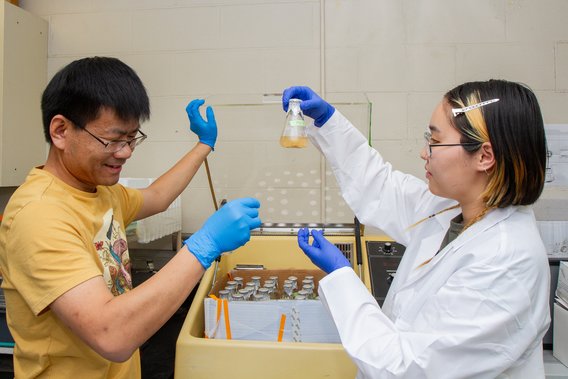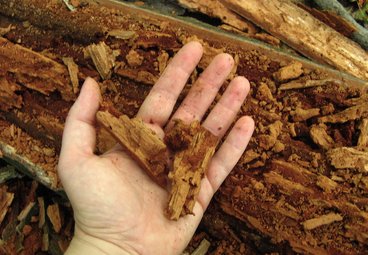By Ann Nordby

Imagine a decarbonized world. In this cleaner, greener place, biomanufacturing is hyper-efficient and circular: All the natural resources used to make products and energy are cycled back into the same system, with no waste.
Getting to net-zero carbon emissions is not an impossible dream. Nature already does this. Right now, scientists at the University of Minnesota are among those using cutting-edge research technology to unlock nature's secrets.
Among the most important questions are these: How does the carbon cycle actually work? And how can we mimic this cycle, to become a carbon-zero society?
Nature uses carbon very efficiently. The most common carbon recyclers are fungi. One group is called wood decomposer fungi. They degrade and recycle the carbons sequestered in trees in a very efficient way. They survive by secreting biocatalysts to deconstruct wood, digesting dissolved molecules as carbon nutrients that in turn, feed new trees and other plants. These fungal processes could show scientists how to efficiently convert biomass to produce goods and energy.

Wood-decomposing fungi are essential players in breaking down plant biomass in forest ecosystems. In the past 10 years, scientists have learned much about how fungi degrade lignocellulose—the primary building block of wood cell walls. Lignin accounts for 30 percent of the organic carbon on earth, so understanding exactly how fungi digest lignin could have broad implications for biofuel production.
Like all scientists doing fundamental research, curiosity drives Assistant Professor Jiwei Zhang, a BBE macrobiologist. "We don't know what genes are driving this fungal process," he said. His second biggest motivation is the possibility that his discoveries could be the springboard for transformational sustainability solutions.
Picky eaters
Zhang leads a University of Minnesota lab that is working to understand a specific and important part of the carbon cycle. Zhang and his research team are using CRISPR gene editing to find out which parts of the wood fungus genome perform various jobs to break down wood. Once understood, could this process be harnessed?
"What genes make fungi unique decomposers? That's my overarching question. I will probably spend my whole career on it," he said recently.

There are two kinds of wood fungi. White rot fungi eat all parts of trees, converting them to food and building material. They live in all forests and scientists have come to understand their processes pretty well in recent years. Brown rot fungi, on the other hand, are pickier eaters. They are the primary decomposers in northern boreal forests. They recycle the encased carbons in coniferous trees back into the ecosystem, but leave behind lignin, the hardest part of the wood, in skeleton-like structures that any northwoods hiker can see. It's too hard to digest, so they leave it behind. It's an efficient process. The question is, how do brown rot fungi recognize lignin and how do they avoid it?
"It's a mystery," Zhang said.
To solve the mystery, he and his lab are snipping out specific genes in the fungus's genome, then exposing them to wood. The US Department of Energy funds Zhang's research. For this project, the University of Minnesota has two partners. The Pacific Northwest National Lab and Lawrence Berkeley National Laboratories. They provide the transcriptomic large-scale gene sequencers and access to the data discovered by other scientists. This common data provides a national resource for all scientists working on this important question.

Gene-editing has become much more accessible in recent years. CRISPR allows scientists to cut out a specific gene from a genome and replace it with another. "Basically, you use Cas9, or any cas proteins, to target the genes," Zhang said. "You can think of it as withdrawing or deleting certain genes from the genome. Then, we study the phenotypes of the fungi after you have done that."
Along with efficiency, the other thing that brown rot fungi do well is to sequester carbon. The left-behind lignin stays in the soil, rather than releasing in a CO2 format. Carbon sequestration could be a strategy to combat global warming while humans figure out how to achieve carbon zero.
"For some reason, brown rot fungi developed evolutionarily to have these tools to get access to the carbohydrates. This tool potentially could be used by our society to develop a more sustainable environment and economy," Zhang said.
Pure science

The current brown rot fungi project, funded by the US Department of Energy, will produce a toolkit for understanding fundamental microbial processes relevant to energy production. This toolkit could help engineers to make biofuels more efficient. Every advance in efficiency makes biofuel production more sustainable.
In addition to this study, Zhang's lab is also studying biodegradation polymers and PFAS degradation. PFAS is a group of widely used, long-lasting chemicals that are now found in people and animals all over the world and may be harming health. As scientists have always done, Zhang is unlocking nature's mysteries to discover tools for healthy living.